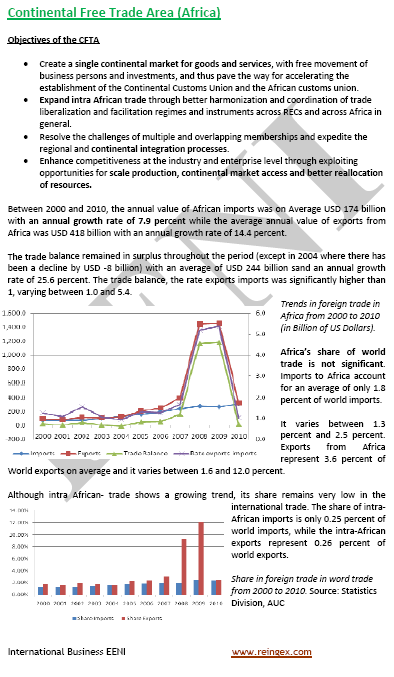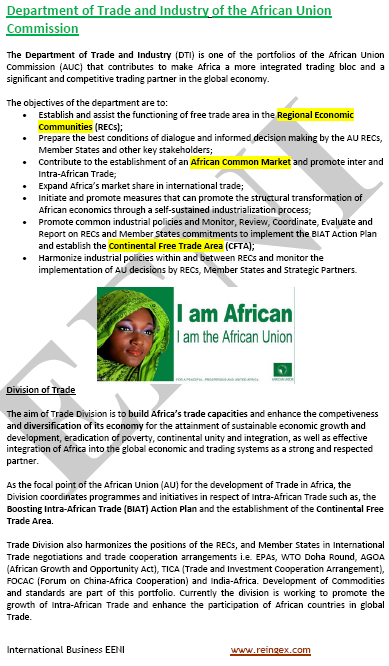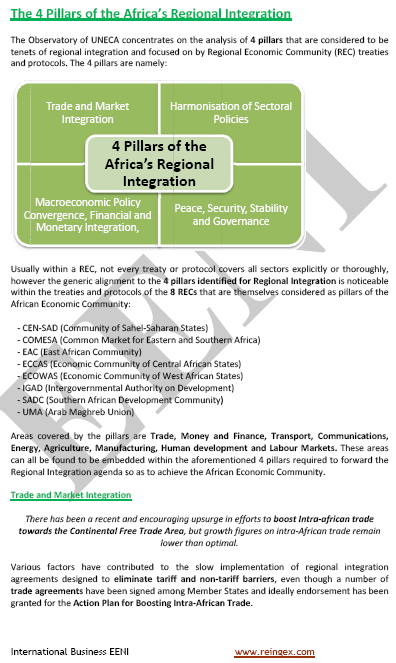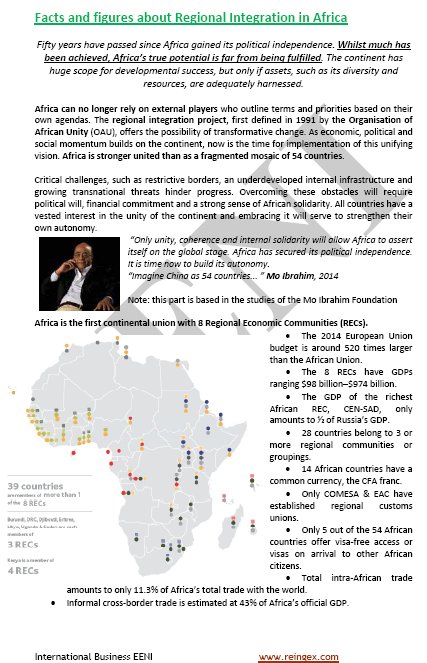African regional integration (Online Bachelor)
Optional Subject - African regional integration: towards the African Continental Free-Trade Area (Bachelor of Science in Inter-African Business, e-learning, Sixth semester, optional)
| Bachelor of Science in Inter-African Business |
Subject (optional) - “African regional integration: towards the African Continental Free-Trade Area (AfCFTA)” (8 ECTS) - Online Bachelor of Science in Inter-African Business (Sixth semester).


The main objective of the Optional Subject “African regional integration” is to understand the irreversible African Integration process whose ultimate goal is the creation of the “African continental free-trade area”.
The specific objectives are the following:
- To understand the fundamental role of the African Union, the Economic Commission for Africa (CEA), the African Development Bank and the regional economic communities (REC) and the overlapping (“Spaghetti bowl”) in African Integration process
- To understand the four pillars of regional integration of Africa
- To understand the concepts of the African Economic Community, the African Customs Union and the future “African Common Market”
- To know the strengths and weaknesses of the African Integration
- To know the state of the integration regional African
- To determine the barriers to the Intra-African Trade
- To know the implications of the Action Plan for Boosting Intra-African Trade (25% of the intra-African trade)
- To understand the integration of the African Financial system and the role of Cross-border banking
- To learn the ICT advantages applied to the inter-African Trade
- To understand the role of the infrastructures and ICT (“African Mobile Revolution”) in African Integration process
- To know the PIDA (Programme for Infrastructure Development in Africa)
- To evaluate the costs of International Trade (imports/exports) in Africa
- To know how the African companies can take advantage of the African Value Chains
- To know two good examples of integration: OHADA (Organization for the Harmonization of Business Law in Africa) and Tripartite Agreement (COMESA-EAC-SADC)
- To know the paths towards African Continental Free-Trade Area (ZLE), the advantages for Africa and the possible stages of the ZLE
Syllabus of the Program - introduction to the African regional integration
1- Introduction to the African Integration.
- History of the African regional integration process
- Treaty of Abuja
- Towards the African Economic Community (CEA)
- Trade agreements and Protocols on Regional Integration
2- Regional Economic Communities (REC) in Africa (summary).
- CEN-SAD (Community of Sahel-Saharan States)
- TCOMESA (Common Market for Eastern and Southern Africa)
- EAC (East African Community)
- ECCAS (Economic Community of West African States Central)
- ECOWAS (Economic Community of West African States)
- IGAD (Intergovernmental Authority on Development)
- SADC (Southern African Development Community)
- AMU (Arab Maghreb Union)
- Introduction to the Tripartite Free Trade Agreement COMESA-EAC-SADC
3- Other African Economic Organizations (summary).
- SACU (Southern African Customs Union)
- MRU (Mano River Union)
- COI (Indian Ocean Commission)
- WAEMU (West African Economic and Monetary Union)
- WAMZ (West African Monetary Zone)
- ICGLR (International Conference on the Great Lakes Region)
- CEMAC (Central African Economic and Monetary Community)
4- The four pillars of the African regional integration
- Facts and figures about African regional integration
- Macroeconomic Policy Convergence, Financial, and Monetary Integration
- Harmonization of Sectoral Policies
- Trade and Market Integration
- Peace, Security, Stability, and Governance
Syllabus of the Program - State of the African regional integration:
- Assessing African regional integration (ARIA)
- Developments in the major areas across the Regional Economic Communities
- Macroeconomic policy convergence
- Mainstreaming regional integration
- Free movement of people and right of establishment
- Physical African integration
- Developments at inter-REC and continental levels
- Trans-African Corridors initiatives
- Harmonicing Rules of origin across Africa
- Market Access and Services
- Trade Facilitation Measures and Programs
- Best Practices in African regional integration
Syllabus of the Program: Action Plan for Boosting Intra-African Trade
1- Introduction to the Intra-African Trade.
- Structure of the African Trade
- Barriers to the Intra-African Trade
- African exports diversification
- Lack of infrastructures
- Free-Trade Areas
- Cross-border trade
- Trade liberalization
- Trade barriers
- African Customs
- Information and communication technologies
- Information networks
- High costs of doing business in Africa
- Financial markets and access to credit
- Currencies: Multiplicity and non-convertible. The case of the CFA Franc and the South African Rand
- Free movement of persons, labour and capitals
2- Action Plan for Boosting Intra-African Trade.
- Trade Policy
- Trade Facilitation
- Trade and infrastructures
- Trade Finance
- Information on Trade
- Factor Market Integration
- towards the African Continental Free-Trade Area
Objectives of the Program “Intra-African Trade”:
- To know the structure of the African Trade
- To evaluate the Technical Barriers to the Intra-African Trade
- To analyze the programs of foreign trade liberalization
- To understand the role of the African Customs
- To know the Action Plan for Boosting Intra-African Trade to increase 25% the Intra-African Trade of the Economic Commission for Africa (CEA)
Syllabus of the Program: ICT, Trade and African regional integration.
- Information and communication technologies, trade and African regional integration
- E-Commerce: The next growth frontier of Africa
- Initiatives of the Regional Economic Communities
- ICT and trade facilitation in Africa
- Automated System for Customs Data
- Single windows in Africa
- Case Study: Kenya Ports Authority and Kilindini Waterfront
- Automated Terminal Operating System
- ICT and transport corridors
- ICT and payment systems
- Cross-border mobile payments
- Case Study:
- Nigerian online retailers (DealDey, Konga, Jumia)
- East African Payment System
Syllabus of the Program: Regional African Financial Integration.
- Introduction to the Regional African Financial Integration
- Trends in the African Regional Financial Integration
- Case Study: The largest African banking groups;
- ECOBANK (Togo)
- BMCE - the Moroccan Bank of Foreign Trade (Morocco)
- Attijariwafa Bank
- Payment systems in Africa
- Cross-border banking
- Risks of Cross-border banking
- Mobile banking services
- Development of capital markets
- Regional Financial Infrastructure
- Agreements on monetary cooperation of the Regional Economic Communities
- Sending of funds by mobile phone in Africa
- Case Study: Vodafone Money Transfer (M-PESA) in Africa
- West African Development Bank of the ECOWAS
- Financial system of the WAEMU
- Case Study:
- United Bank of Africa (Nigeria)
- Standard Bank (South Africa)
Syllabus of the Program: Infrastructures and telecommunications in Africa.
1- Infrastructures in Africa.
- African Infrastructure Knowledge Programme
- Infrastructure Consortium for Africa
- Investment trends in infrastructures in Africa
- Information and communication technologies
- Growth of the Information and communication technologies (ICT)
- African Mobile Revolution
- Irrigation
- Power
- Sanitation
- Water Resources and Supply
- Analysis of infrastructures in Africa
- Infrastructures and African economic growth
- Infrastructures and poverty reduction
- Africa's institutional framework for infrastructure
- Urbanization and services distribution
- Regional integration and infrastructures
2- Programme for Infrastructure Development in Africa (PIDA).
- Introduction to the Programme for Infrastructure Development in Africa
- Key sectors:
- Energy
- Transport
- Information and communication technologies
- PIDA's outcomes: development through the regional integration
- Costs and investments
Syllabus of the Program: African value chains.
- Introduction to the African value chains
- Opportunities for the African Companies
- African Growth Poles
- How can take advantage the African enterprises of the value chains?
- FDI Cooperation
- Trade Facilitation
- Rules of Origin and transport costs
- Export costs in Africa
- One-stop border post
- Case Study:
- Cocoa Value Chain in West Africa
- Shoprite (the African largest food distributor)
Syllabus of the Program: African continental free-trade area (AfCFTA).
- Introduction to the African continental free-trade area
- Why Africa needs the Continental Free-Trade Area?
- Theories of the Free-Trade Areas
- Towards the African free-trade area
- Main objectives of the African continental free-trade area
- Intra-African Trade
- Advantages of the continental free-trade area
- Empirical Impact and Analysis of the African Continental Free-Trade Area: economic gains and losses
- Potential scenarios to achieve the African continental free-trade area:
- Free-Trade Area of the Eastern and Southern Africa (COMESA, SADC, EAC, IGAD) - Tripartite Agreement
- Free-Trade Area of the Northern and Western Africa (ECOWAS, CEN-SAD, ECCAS and AMU)
- Economic impacts of the Continental Customs Union
- Perspectives of the CFTA
- Road Map and Architecture of the African Continental Free-Trade Area
- The main bodies of the African Continental Free-Trade Area
Objectives of the Program “African continental free-trade area (AfCFTA)”:
- To understand the objectives and role of the agencies of the African continental free-trade area
- To evaluate the advantages and economic impact for the African Countries of the African continental free-trade area
- To analyze the two possible stages for the realization of the African Continental Free-Trade Area
- To know the roadmap and architecture of the African continental free-trade area

- ECTS = European Transfer and Accumulation System
- CECT = Credit of Capitalisable and Transferable Evaluation (CAMES)
Samples: African regional integration - towards the African Continental Free-Trade Area (AfCFTA) (Bachelor of Science in Inter-African Business, e-learning, Sixth semester, optional).






Language of the subject (optional) “African regional integration: towards the African Continental Free-Trade Area (AfCFTA)” of the Bachelor of Science in Inter-African Business taught by EENI Global Business School (Sixth semester):
 or
or  EENI
EENI  EENI
EENI  EENI.
EENI.
(c) EENI Global Business School (1995-2024)
We do not use cookies
Top of this page

